In a groundbreaking advancement poised to transform targeted drug therapy, researchers have unveiled a magnetically guided microrobotic system capable of navigating the complex vascular and bodily passageways with exceptional precision, promising to minimize off-target drug exposure and side effects. This innovative technology addresses one of the most daunting challenges in medicine today: delivering therapeutics directly to diseased tissues while circumventing systemic toxicity that frequently undermines treatment effectiveness and patient safety.
Traditional systemic drug administration methods remain plagued by a high incidence of unintended side effects. These adverse outcomes, often resulting from drugs interacting with healthy tissues, contribute significantly to clinical trial failures, underscoring the pressing need for novel approaches capable of achieving pinpoint accuracy in drug delivery. Building upon emerging advances in nanotechnology, materials science, and biomedical engineering, the latest research harnesses tiny, wireless microrobots whose precise movements within the body’s labyrinthine environments are controlled magnetically.
The team, led by Fabian Landers and collaborators, introduces a modular platform integrating a sophisticated electromagnetic navigation system dubbed Navion with an engineered release catheter and a drug-loaded, dissolvable gelatin capsule. These microrobots, composed primarily of biocompatible, biodegradable gelatin embedded with magnetic and radiopaque nanoparticles, allow real-time tracking via X-ray imaging while simultaneously ferrying therapeutic payloads. This integration of locomotion, navigation, imaging, and controlled drug release into a single system marks a pivotal step toward clinical viability.
Unlike tethered devices, these microrobots operate untethered, enabling maneuverability through intricate vascular networks including the cerebral vasculature and cerebrospinal fluid spaces. Through strategic application of magnetic fields generated by the Navion system, the microrobots can be guided over tremendous distances relative to their size, negotiating sharp turns and bifurcations with remarkable dexterity. This precise control facilitates access to even the smallest and most elusive blood vessels, historically inaccessible to previously existing drug delivery modalities.
Importantly, once the microrobot reaches the target site, the release mechanism kicks in through localized, controlled heating. This heat stimulus triggers the dissolution of the gelatin capsule, thereby releasing the encapsulated drugs directly into the targeted tissue microenvironment. The capsule’s biodegradable nature ensures that no permanent foreign material remains post-delivery, significantly reducing the risk of long-term complications arising from device implantation.
To validate their platform, Landers et al. conducted extensive in vitro experiments using human vascular models that mimic the anatomical and physiological characteristics of human blood vessels. These experiments demonstrated not only navigational precision but also effective, targeted drug release confined to intended sites. Extending their proof of concept, the researchers further tested their system in vivo with large animal models, including sheep and pigs, under conditions that closely replicate human clinical settings.
Remarkably, the in vivo trials underscored the system’s potential in real-world applications. The microrobots successfully traversed the complex biological terrain, navigating through natural fluid flows and anatomical constraints without invasive surgical intervention. Additionally, controlled dissolution and drug release at prescribed locations were achieved without adverse physiological reactions, highlighting the platform’s safety and efficacy potential.
The research does not exist in isolation. Prior studies referenced by the team illustrate complementary advances, including the use of magnetic microrobots for treating infections deep within sinus cavities and employing ultrasound combined with magnetic controls to manipulate microrobots for targeted therapy. Such interdisciplinary synergies bolster the prospects for widespread adoption of microrobotic technologies in diverse medical applications.
Despite these achievements, the authors acknowledge significant hurdles remain on the path toward full clinical translation. Challenges lie in ensuring biocompatibility across variable patient physiologies, scaling manufacturing processes for consistent quality, refining imaging integration for seamless operation, and navigating the complex regulatory landscape governing medical devices. Nonetheless, the presented framework offers a robust foundation and direction for ongoing innovation.
The implications of this breakthrough extend far beyond drug delivery for vascular diseases. The ability to traverse anatomically complex and sensitive regions of the body non-invasively opens avenues for therapies in neurology, oncology, and infectious diseases, where precise dosing and minimal collateral damage are paramount. Furthermore, the modularity and programmability of the magnetic guidance system offer adaptability to multifarious therapeutic agents, including bioactive molecules and gene-editing tools.
In summary, the development of clinically ready magnetic microrobots integrating electromagnetic navigation, real-time imaging, and biocompatible drug release mechanisms promises to revolutionize targeted medical therapies. By converging multidisciplinary expertise across engineering, physics, and medicine, the technology embodies the future of minimally invasive precision medicine. Continued refinement and clinical testing hold the key to transforming these small marvels into everyday therapeutic workhorses.
Fabian Landers and colleagues’ contribution epitomizes the forefront of bio-robotics applied to health care. Their work energizes a dynamic field seeking to mitigate the perennial problems of systemic drug toxicity while enhancing therapeutic outcomes. As these magnetically guided microrobots edge closer to clinical application, patients and healthcare providers alike may soon witness a new era of precision-targeted treatment.
Subject of Research: Magnetically guided microrobotics for targeted drug delivery in complex biological environments.
Article Title: Clinically ready magnetic microrobots for targeted therapies
News Publication Date: 13-Nov-2025
Web References:
DOI: 10.1126/science.adx1708
Keywords: Magnetic microrobots, targeted drug delivery, electromagnetic navigation, biodegradable capsules, vascular navigation, precision medicine, real-time X-ray imaging, minimally invasive therapy, gelatin-based microrobots, drug release control, in vivo validation, bio-robotics
Tags: biocompatible drug delivery systemsbiodegradable drug carriersbiomedical engineering breakthroughselectromagnetic navigation in medicinemagnetically guided microrobotsminimizing drug side effectsmodular drug delivery platformsnanotechnology in healthcarePrecision Medicine Advancementsreal-time tracking of therapeuticstargeted drug delivery innovationswireless microrobotic systems





